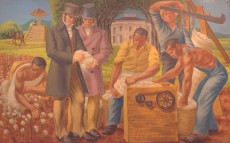 In 1956 George Beattie painted a series of eight murals on the walls of the Georgia Department of Agriculture in Atlanta. The murals were removed in 2011 when newly elected agriculture commissioner, Gary Black, decided that the murals were inappropriate. Two of the eight murals depicted scenes of slavery. Black stated at the time, “I think we can depict a better picture of agriculture.”
In 1956 George Beattie painted a series of eight murals on the walls of the Georgia Department of Agriculture in Atlanta. The murals were removed in 2011 when newly elected agriculture commissioner, Gary Black, decided that the murals were inappropriate. Two of the eight murals depicted scenes of slavery. Black stated at the time, “I think we can depict a better picture of agriculture.”
Now the Georgia Museum of Art at the University of Georgia will display four of the eight murals. Paul Manoguerra, curator of American art at the museum said, “As the official state museum of art and as an academic institution, the Georgia Museum of Art believes it is important to preserve this aspect of Georgia’s history. The murals present one artist’s attempt to address the complex history of agriculture in our state in 1956.”
 Valerie Babb, professor of English and African American studies and director of the Institute for African American Studies at the University of Georgia, added, “I don’t think you learn anything by hiding history,” said Babb. “I think it’s very important to have conversations about why these panels were painted in the first place, as well as why they were taken down and what that reveals about the way we as a culture and a society have changed.”
Valerie Babb, professor of English and African American studies and director of the Institute for African American Studies at the University of Georgia, added, “I don’t think you learn anything by hiding history,” said Babb. “I think it’s very important to have conversations about why these panels were painted in the first place, as well as why they were taken down and what that reveals about the way we as a culture and a society have changed.”
Professor Babb is a graduate of Queens College, part of the City University of New York system. She earned a master’s degree and a Ph.D. from the University at Buffalo.












When we decide, for whatever reason NOT to tell the whole story, we need to say we have consciously decided not to tell the whole story…AKA the truth.
Professor Babb speaks truth to power. The questions really are around the discussion of why we want to leave this out.
One short but informative book in this area of leaving stuff out/not telling the wholw story is Einstein on Race and Racism a whole book on what you will not find in all those other biographies on Einstein. Medical Apartheid, a longer read, is another telling “the rest of the story” book. To find out that Addie Mae Collins was not in her grave. Yes, one of the Birmingham church bombing victims (from Civil Rights era, for you youngsters) was discovered not to be in her grave when several decades later her sisters tried to unite her in a cemetery with other family.
I, by the way, just read. I have no place in a scholarly discussion but most folks are just like me…we just read and, in my case, specifically the history of our people.
I am a former Georgia resident but currently live in Maine where we had our own mural brouhaha recently.
Thank you for this space.